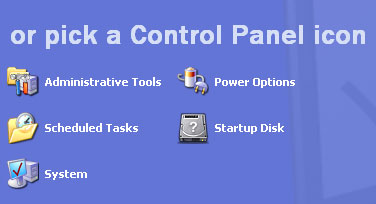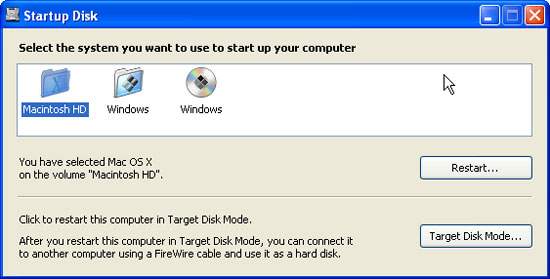Apple's MacBook Pro: Using it as a Mac and a PC
by Anand Lal Shimpi on April 13, 2006 12:00 AM EST- Posted in
- Mac
I had to enter my CD key and deal with activation just like you would on a PC, and then I was placed at the Windows desktop. The next step was to toss in the driver CD created earlier, and Windows' autorun feature will start a driver installation wizard for the MacBook Pro.
While there's an occasional Continue or Next button to click, the process is mostly automated as it installs the MacBook Pro's chipset, video, audio, network and input drivers. Thanks to having complete control over the hardware configuration Apple has made the process of installing Windows on your Mac easier than it is installing it on your PC. With all of the drivers installed, there's one last reboot and the process is complete. I'd just installed Windows XP on my MacBook Pro and now it's time to use it.
![]()
After installing Windows XP, by default the MacBook Pro boots to the Windows partition . This behavior can be changed in the Startup Disk utility: Control Panel > Performance > Startup Disk and select the default boot partition. If you happen to have a bootable CD/DVD in the drive you can even choose to boot from that.


While the control panel option will permanently change the system's default behavior, if you want to temporarily boot to a different partition simply hold down the option key while the MacBook Pro starts up to access the boot menu.

It takes no more than a few minutes using Windows XP on the MacBook Pro before you realize that a number of things feel out of place. The biggest problem is that there's no right mouse button, which in OS X you get around by holding down the ctrl key and clicking, but in Windows XP ctrl + click does nothing. There is a utility out there that will make holding the ctrl key down swap your left and right mouse buttons temporarily, effectively making ctrl + click function as a right click under Windows. The utility works as advertised; you just need to make sure it loads at startup to always have support for a right mouse button. The other option to right click is to hit Shift + F10, but obviously it's not the most natural feeling.
Apple's driver CD installs a driver to enable support for the eject key on the MacBook Pro keyboard, which is very helpful because without it or any support for a right click, getting a CD/DVD to eject is far more trouble than it should be. The fn key is also not supported under Windows XP, which means that not only do you lose support support for the function hotkeys but you also lose any support for page up, page down, home and end keys.
Although Apple clearly states that the integrated iSight camera is not supported under Windows XP, a camera icon does show up in My Computer. However, I made the mistake of doubling clicking it which gave me my first blue screen on a Mac. Needless to say, I didn't make that mistake again.
My only other complaint about using Windows XP under Boot Camp on the MacBook Pro is that I could never get the mouse sensitivity to be at a level I was perfectly comfortable with. The default setting was far too slow (just like under OS X), but cranking it up to where I would like it made the pointer behave a little too erratically when trying to perform more minute movements. The trackpad was obviously fine under OS X, so it sounds like it's just a driver thing under Windows XP.
In terms of usability, Windows XP under Boot Camp is pretty much like Windows XP on any other notebook other than the aforementioned keyboard/trackpad limitations; I've got no complaints there. And yes, you can even run games on your notebook, but keep in mind that the MacBook Pro's Mobility Radeon X1600 isn't going to be able to run the latest games at their highest detail settings.
Honestly, it would seem that fixing the issues I had with Boot Camp would be fairly simple for Apple to do with a more extensive keyboard driver. Much like Apple did with their eject button driver, doing the same for the other keys that currently don't work would fix a lot of the problems. It could be that Apple either released the Boot Camp beta earlier than it expected to, or that Apple wants to make the Windows XP experience as poor as possible on the MacBook Pro.










52 Comments
View All Comments
mzlin - Saturday, April 15, 2006 - link
Excellent review, Anand! The Parallels vs Boot Camp comparisons are really well done and very helpful.I thought the comment about PowerBook weight being 1/3 more than any other laptop you've used was a little misleading. I'm sure you didn't mean to say the PowerBook was especially heavy, but since you didn't actually mention what it weighs (5.6 pounds), it could be construed as the Powerbook weighs 1/3 more than other 15.4-inch laptops.
I have been looking for 15.4-inch laptops, PC or Mac, that weigh less than 6 pounds with an integrated optical drive. (For me, having the drive integrated is non-negotiable; I wouldn't want to have it in the wrong place when I needed it, so I would be carrying it around regardless, and much better to save the hassle of digging it out and plugging it in when one needs it.) But the Powerbook/MacBook is the only one I have found so far. On the PC side, the VAIO BX and Toshiba Satellite A105 manage to get to 6.0 pounds, but are also are 1.5 inches thick.
hechacker1 - Saturday, April 15, 2006 - link
I'd just like to point out that the buzzing due to power state switching (transitioning between C3 and C4 states) also happens in windows and linux. It's purely a hardware issue, and in most cases it just means the manufacturer used low quality components (capacitors).In windows it is not as noticible because it runs with a kernel frequency of 100Hz. In linux it's often run with 1000Hz. Because of the increase in frequency of power state switching the buzzing becomes audible to the ear.
In windows it happens 10 times less than most linux boxes. Hence you don't hear it as much even with low quality components. My own Dell 700m laptop has this issue.
The only solution in linux is to disable the lower power states, or change the kernel timer to 100Hz like windows. The best solution is to use dynamic tick switching so you get exactly the responsiveness you need, only when you need it. With a patched linux kernel my laptop automatically goes to 54Hz when idle, and 1000Hz when under load.
Anyways... the only reason those "fixes" work is probably because they cause the processor to do just enough work to avoid having to go into the lowest power mode.
corequadro - Friday, April 14, 2006 - link
I found it as a perfect help against the annoying whine. Just start and then stopp it, and you will – if you aren't using ichat – have a perfectly silent macbook till the next reboot.Of course, a fix from Apple would be more effective, but I can live with the widget fix.
brich - Friday, April 14, 2006 - link
I really think the MacBooks have legs to grow, especially once the intel transition is completed over the next year and universal support becomes more 'universal.' My 12" PowerBook G4 1.5 has served me very well, even with the limitations of XP Pro running in VPC 7 inside Tiger. I think that some of the PC-only enthusiasts who add a MacBook to their arsenal will discover that the integration of excellent hardware esthetic and design with an OS that is continually developing/improving (OSX) will make the Mac solution quite compelling.That said, if I were a user who was totally satisfied with Windows and was not interested in OSX, then I would not buy a Mac to run Windows...no reason to do it. The real differentiation is the new flexibility of the intel Macs with OSX as a viable alternative to XP now and Vista later. Ther ability to run XP on them is frosting on the cake, imho.
ohnnyj - Friday, April 14, 2006 - link
Dear Apple,I want a 12in Merom MacBook.
Desslok - Thursday, April 13, 2006 - link
Acorrding to Daily Tech the hardware bugs you talked about are fixed with the new revs of the MacBook Pro. The article also stated that Apple would allow you to trade your MacBook in if you were having these problems.JAS - Thursday, April 13, 2006 - link
Tonight, I visited an Apple Store to see the MacBook Pro in person. What a gorgeous, well engineered laptop -- and impressively fast! The units on display did have rather warm undersides; but perhaps these are from the initial manufacturing run ("version A").trooper11 - Thursday, April 13, 2006 - link
Great job on the review, it was interesting to see how close things are coming on the software side to run a Windows environment on Macs and pointing out how similar Macs have gotten to every other laptop maker, at least in terms of parts and performance.The thing that gets me now is that the change over to Intel processors and ,in general, a more universal system, has made the Mac just another notebook vendor. So whst the Mac Book Pro has going for it is OS X and any of the Apple software, the machine itself is no better or worse then the many laptop manufacturers putting out Windows based pcs. In the past Macs had sort of mystique relating toa percieved uniqueness.
If everyone realizes this, then Id like to see a review of a Mac Book from the perspective of any normal system evaluation. Comparing the experience with Apple with those of HP, Dell, Acer, or even Lenovo. If Im not a fan of the Mac OS, then I dont see any other reason to pick them over say Acer or Lenovo. I certainly wouldnt pay a price premium for the Apple name unless I saw some first hand reviews relating to price/performance and quality of service you can expect.
anthlover - Thursday, April 13, 2006 - link
Those who have a powerbook that runds under 1ghz will be well served by the new books NOW. Those that have 1.5 and 1.67 have not need to quickly switch unless there is some native apps including apps free ones they want to use.Those that have no book will do well with them.
Waiting unless somthing new was coming out in a couple of weeks is silly. Computers and their prices change constantly, models are refreshed and replaced rapidly. One should always buy what they need and try to future proof too much.
Of course those wanting to save might want to wait for the Ibooks err Mac Book.
Glad to hear replacing the drive got **easier then on the earlier Alumibooks... Or at least the 12 inch one. I got through the keyboard replacement part of the disasemly I had done before and then read ahead to the upper case disassembly and realized that I need a brighter room, no cats trying to help, and a lot of care. Too much risk. With the books It sounds like when you want that 200gb 7200 rpm drive it will be easy to put in:)
plinden - Thursday, April 13, 2006 - link
The choppiness can be made almost unnoticeable by reducing the "Hardware acceleration" - Display Properties/Settings/Advanced/Troubleshooting, and move the slider one notch to the left.